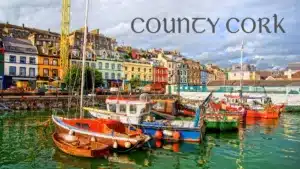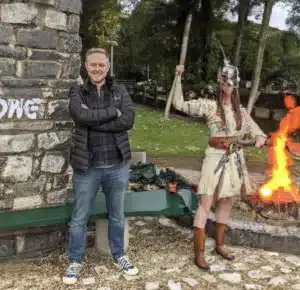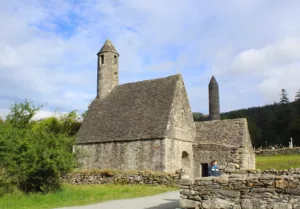Have you Visited the Irish Famine Museum?
Many of our shared ancestors left Ireland because of the Great Irish Famine. Here is the story of just one of those locations that was severely affected - and it became the site for the Irish Famine Museum today.

A couple of weeks ago, we were on an Irish road-trip around the north-west counties of the island. One of the most striking locations was a place called Strokestown Park House in County Roscommon. And that is the focus of our letter today.
The Strokestown Park estate sits in the middle of 11,000 acres in the rolling hillside of County Roscommon. Today, the beautiful house and stables (which houses the Irish Famine museum) are open to the public.
The house was built about 1735 on land granted to the Mahon family in 1653. It was a grand house, and must have been the scene of many major social occasions within the county. However, by the time the Great Famine arrived in 1845 – the population in Roscommon (and much of Ireland) had swollen to unsustainable levels. There was about one person per acre on the estate. Not only that, but following years of neglect and mismanagement by absentee landlords – the estate was over 30,000 pounds in debt.
The estate was then inherited by Major Denis Mahon. Major Mahon was, as before, and absentee landlord. The day-to-day affairs of the estate were handled by his land agent. As the Famine gained a grip on the surrounding countryside, the ability of the tenants to pay any sort of rent to their landlord quickly vanished. Major Denis Mahon had to make some hard decisions with the help of his land agent, John Ross Mahon.
They needed to clear the land of some of the “worst tenants” – those who looked as if they would never improve the land or pay their rent. After some investigation, they calculated that it would cost about £11,000 each year to maintain these “worst cases” in the local workouse. A cheaper option was to fund a one-off emigration scheme to move them to new lands in Quebec in what is now Canada. In either case, the land would be partially cleared and could be divided among the remaining, more productive tenants. Seems like a simple business problem, doesn’t it?
What would you do if you were in Major Denis Mahon’s situation? Move the worst tenants to the nearby workhouse? Move them to a new country? Something else?
Well, in May of 1847 – 1,490 of the tenants of Strokestown Park started down the pathway beside the Royal Canal. Their destination was the port of Dublin – about four days away. From there, they would go to Liverpool – wait about a week – and then board four ships for the voyage to Quebec. They were accompanied by the Bailiff to ensure they all made their way to Liverpool.
However, these people were already weakened from months of malnourishment before setting off on a long walk. Can you imagine how vulnerable they were as they arrived in Liverpool – a city already host to many outbreaks of cholera and typhus? The families were loaded onto four ships in Liverpool: the Naomi, the John Munn, the Erin’s Queen and the Virginius – their first port of call was to be the quarantine island of Gross Isle on the Saint Lawrence River in Quebec.
It turned out that Major Mahon’s agent had looked to save as much money as possible on this emigration scheme – and had reserved the cheapest boats with the most meagre of rations and medical support for the passengers. These ships – carrying the ex-tenants of Strokestown Park had the dubious honour of being the first named as “Coffin Ships” during the Great Famine.
For example, the Virginius – initially carrying 496 passengers – arrived in Gross Isle having lost 158 passengers during the passage or shortly afterwards. The number of deaths on the other ships were in similar proportions.
Upon their arrival at the quarantine island, Dr. George Douglas, a medical superintendent, described the Strokestown Park emigrants as “ghastly yellow looking spectres, unshaven and hollow cheeked, and, without exception, the worst looking passengers I have ever seen; not more than six or eight were really healthy and able to exert themselves.”
Today, many of these people are remembered on the memorial wall on the island of Grosse Île. It includes surnames from Strokestown Park such as:
Beirne, Brennan, Conboy, Connolly, Connor, Cunningham, Dolan, Donnellan, Duffy, Farrell, Feeny, Flanagan, Gilleran, Hanly, Hayden, Healy, Higgins, Kenny, Lyons, Mannion, McDermott, McDonnell, McHugh, Mullooly, Murray, Owens, Reynolds, Rodgers, Ryan, Sharkey, Whelan
and many more. Are any of your Irish surnames here? Do let a comment below and let me know.
In November of 1847, Major Denis Mahon was assassinated when travelling back to Strokestown Park. It was the first landlord killing of the Famine, and it is believed that it was in direct response to the news of the high mortality rate reaching the remaining tenants on his land.
The Irish Famine Museum.
After Mahon died, his daughter Grace vowed to never return to Strokestown. However, the eviction of tenants continued for many years after the end of the Famine. Strokestown Park was improved over time and remained in the hands of the Mahon family until 1979. At that point, the house and gardens were sold to a local businessman who intended to develop it as a luxury hotel. However, when tidying up the house, the new owners came across many thousands of documents relating to the history of Strokestown Park and County Roscommon – many telling the stories of gentry, officials and tenants at the time of the Famine. As a result, the house was kept in its original state and the “National Irish Famine Museum” was established in the old stables.
It’s a wonderful place to visit – the countryside is lovely, the house stands as a beautiful reminder of how a small minority once lived. As you make your way around the Famine Museum in the stables, you will quickly become aware of the stories of so many of the individuals who lived on this land at such a terrible time for many of our shared ancestors. Here is a link to Strokestown Park website – do have a look!
How about you? Did any of your Irish ancestors leave during the time of the famine? Do you think their experiences were similar to the tenants of Strokestown Park? Do leave a comment below and let us know.
That’s it for this week. We do look forward to you joining us again next week.
Slán for now, Mike & Carina.










Only Plus Members can comment - Join Now
If you already have an account sign in here.